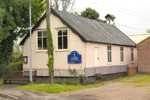For this church:    |
|
 The
church from the The
church from thesouth, showing the porch |
Corrugated iron was a very modern building material at the time. The corrugation added enormous strength to the material. It was then galvanised which prevented corrosion, and extended its life. The windows in St Aidan’s church are simple rectangles; there is a porch on the South wall.
We do not have a record of who erected the building, but it is likely to be C Kent who put up other Tin Tabernacles in the area. The simplicity of the design perhaps shows that the village hoped for a more permanent building one day in the future. It is likely that the residents of Caythorpe helped with its erection. The church reputedly seated 100 people.
The land for the Chapel was given by the Edge Family who also made a considerable donation. The rest of the money was raised by the villagers and it was dedicated to St Aidan in 1900. There is a record of a Sunday school being held in St Aidan’s Mission Room which was attended by 10 children and they had 17 books.
It has not been possible to find a faculty referring to the foundation of the Caythorpe Church but there is a record of a visit by the Bishop of Southwell celebrating the opening. In his diary he recorded that on Tuesday, 8 March he dedicated the mission church:
St Aidan’s Mission Room was dedicated to the service of God by the Bishop of the diocese. For many years the want of a Church mission room at Caythorpe had been felt. The mission room is an iron building. It was very beautifully furnished. The total cost with interior fittings amounted to £250 and the Bishop helped materially to raise the sum, the remainder of which was subscribed by a friend of Caythorpe and by the people of the village.
In 1910 eleven communicants were recorded in the Parish Magazine. During the 1914-1918 war there is little record other than to say that services continued in the church.
In 1936 Henry Mosley, Bishop of Southwell, arrived in his Austin 7. He went to see Caythorpe and Gonalston churches in that order because he had not seen them before.
Services also continued throughout the Second World War. In 1944 the baptism of Dorothy Lane Archer is recorded and confirmation classes were being held. In 1945 a discussion group and question time was held in the church. Participants had to sit round the coal fire to keep warm.
By 1948 the Church was reported to be in a bad state of repair. The church roof was leaking and half of it had to replaced, and the window sills were found to be rotting.
In 1953 new communion rails were added, also brass hooks on which to hang the cassocks. In 1948 a skeleton choir is mentioned, and also a nominal children’s corner.
By 1956 the churchwardens were left £100 by Mr Thomas Holloway of Merton Cottage for repairs to the church; brickwork and down pipes were made good with this money.
In 1970 there was an appeal for church funds to repair the roof and the money was raised in 2 weeks.
In 1992 the church nearly closed. A surveyor’s report revealed that the church needed £20,000 worth of structural work to be done. Mrs Janet Ridgway, who worshipped in the church, led a campaign to keep it open, and funding was found to carry out the repairs.
In 2001 there is an inventory recording the fixtures and fittings in the church. The following are included: two coat hooks, a bell, strip heaters, 2 vestries for the priest, and lamp shades similar to those in Lowdham church. These last were made by Arthur Furley who was Lowdham’s village blacksmith. The heating system must have been very welcome because there are people in the village who remember sitting round a coal fire in the middle of the room.
The arrival of some new seats obtained from The Palace Theatre in Newark and an electronic organ means worship is enhanced with greater comfort and musical support. The church is also used for an Art Exhibiting as part of the annual Caythorpe show and hosts monthly coffee mornings for residents.
In 2008 the first ever wedding took place at St Aidan’s. Until then the Church had not been licensed for marriage, the ‘mother’ church of St Mary’s, Lowdham being the normal venue. However two local villagers were keen to be married at St Aidan’s. Bishop George of Southwell graciously granted the church a licence and the wedding duly took place on the 14th June, conducted by the Rev Carol Tainton amidst much celebration. By 2011 three further weddings had taken place.






